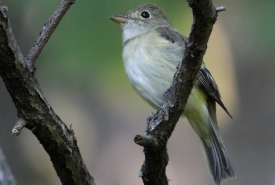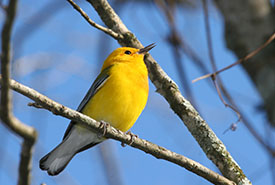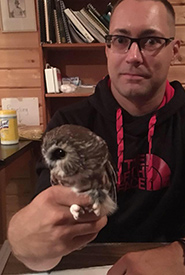Success under pressure: Helping landowners succeed with stewardship in southwestern Ontario

Acadian flycatcher (Photo by Bill Hubick)
The Carolinian ecoregion of Canada makes up one per cent of the country’s total land mass and is limited to southwestern Ontario. Many of the region’s 70 tree species — such as tuliptree, pawpaw and sycamore — are found nowhere else in Canada. It is also home to some of Canada’s rarest wildlife, including at-risk bird species. Unfortunately, the majority of this biodiverse forest habitat has been lost to agriculture or has become heavily fragmented.
The Ontario Forest Birds at Risk Program (OFBAR) at Bird Studies Canada works to ensure that the birds most at risk in this area recover before they are lost forever. We are currently focused on Acadian flycatcher (endangered), cerulean warbler (endangered), Louisiana waterthrush (threatened) and prothonotary warbler (endangered). Each of these species prefers to live in old-growth, mature forests with tall trees and a closed canopy that has been undisturbed for 50 years or more.
Related blog posts
Ninety per cent of the land in southwestern Ontario is privately owned. OFBAR staff are talking to landowners to learn about their land management priorities. This helps us recommend choices for old-growth forest stewardship that both encourages species conservation and meets the landowners’ needs.

Prothonotary warbler (Photo by Bill Hubick)
My colleagues and I have found that our passion for birds and nature is contagious. Woodlot owners’ interest is piqued by our enthusiasm and the appreciation we have for our work. This leads to trust and can mean more landowner-engaged stewardship for birds and other wildlife. It’s a win-win for landowners and species at risk!
Our successes have been small but substantial. We’re motivated to continue making progress on the program’s goals through more landowner stewardship. We currently contact more than 70 private woodlot owners each year to complete surveys for species at risk.
We have built important partnerships with organizations such as the Ontario Woodlot Association, which currently represents 20 regions and thousands of private woodlot owners, conservation organizations such as the Nature Conservancy of Canada and conservation authorities. Maintaining and expanding connections with landowners means positive outcomes for species at risk recovery.
For more information about Bird Studies Canada’s OFBAR program, please email Ian Fife at speciesatrisk@birdscanada.org.


